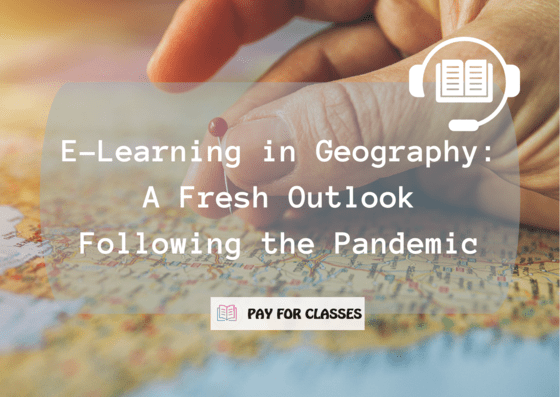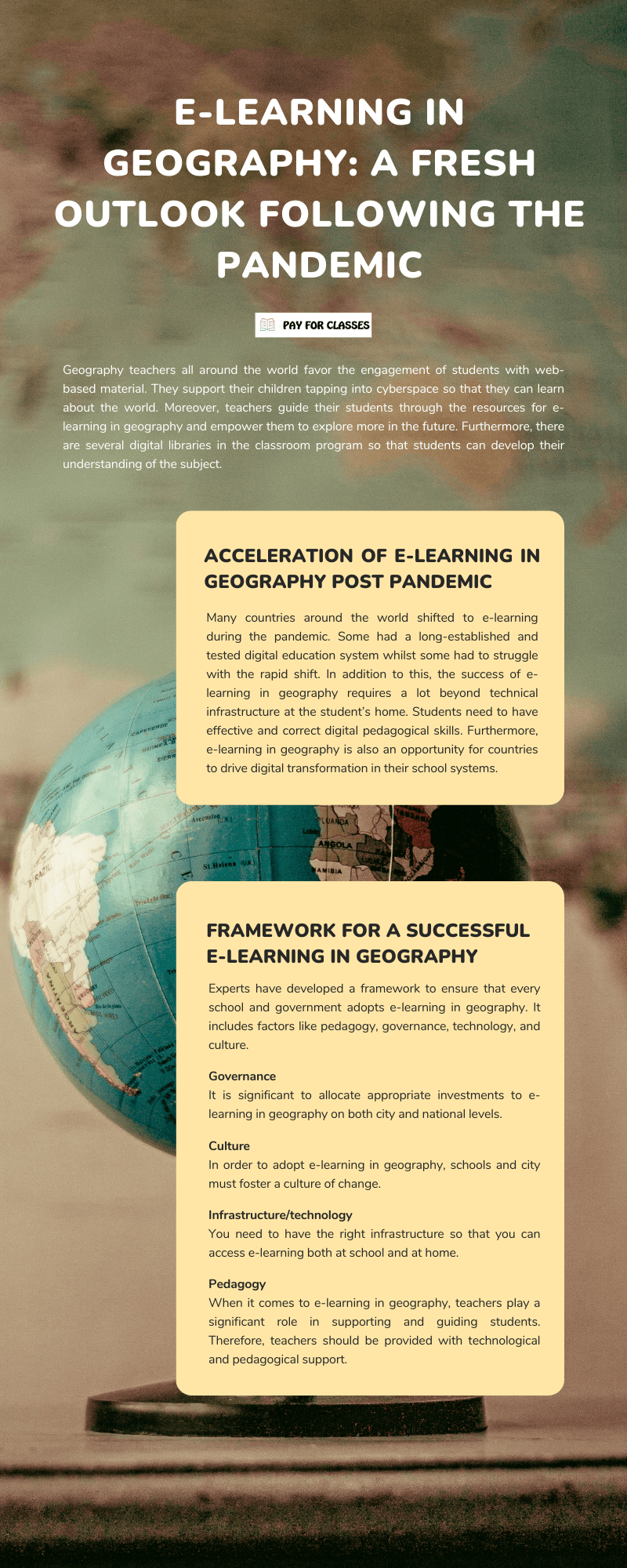
Technology has provided people with a range of potential for education. When it comes to providing context rich in media and the ability to visualize, technology has come a long way. Moreover, it has offered a variety of mechanisms with which students today can easily collaborate and communicate with their teachers and peers. This blog by Pay for Classes describes the integration of e-learning in geography. Furthermore, it outlines learning strategies, transition in learning, digitalization, and a lot more. Now, let us read the blog thoroughly to understand all the aspects of e-learning in geography. Additionally, in case you need someone to take your online class on your behalf then you can post your request with us, such as, I need someone to take my online class for me and we will employ an expert in your assistance.
E-learning in Geography
The notion of creation and the widely used learning object for e-learning in geography is computationally convenient. Reportedly, geography teachers all around the world favor the engagement of students with web-based material. They support their children tapping into cyberspace so that they can learn about the world. Moreover, teachers guide their students through the resources for e-learning in geography and empower them to explore more in the future. Furthermore, there are several digital libraries in the classroom program so that students can develop their understanding of the subject. Additionally, e-learning technology is a great way to evaluate the knowledge students have gained through online tests. Also, let us now read how e-learning in geography has developed over time.
Also read: The Impact of COVID-19 on Online Learning
Acceleration of E-learning in Geography Post Pandemic
It is crucial to ensure that there is not any interruption in learning. However, during the pandemic, when everything was shut down, e-learning emerged as a boon. Reportedly, school closures had a significant financial impact on the society. According to a recent report in Norway, shutdowns of school’s costs €150 per student each day. Moreover, it suggests that students in the future would earn less if we keep school and education on hold. However, the availability of digital tools has effectively managed to lower the negative impact of pandemic on schools and education. Many countries around the world shifted to e-learning during the pandemic. Some had a long-established and tested digital education system whilst some had to struggle with the rapid shift.
In addition to this, the success of e-learning in geography requires a lot beyond technical infrastructure at the student’s home. Students need to have effective and correct digital pedagogical skills. Furthermore, e-learning in geography is also an opportunity for countries to drive digital transformation in their school systems. It will result in better performance of teachers and students. Moreover, students who use e-learning in geography with pedagogical effective use of tools showcase better performance in the respective subject discipline. Also, researchers have seen a huge difference when it comes to high and low-performing students. Alongside this, there is an increased rate of attendance. Hence, we can say that in the coming future, we will be able to see increased digital schools.

Also read: The Benefits of Online Tutoring: How to Find and Utilize Quality Resources
Framework for a Successful E-learning in Geography
Experts have developed a framework to ensure that every school and government adopts e-learning in geography. It includes factors like pedagogy, governance, technology, and culture. Hence, this framework is a result of the impact of the transition from traditional to e-learning. Moreover, it is based on student performance, the schooling system’s performance, and the performance of the national education system.
Governance
It is significant to allocate appropriate investments to e-learning in geography on both city and national levels. Moreover, the country needs to adopt digital skills ad enable e-learning in curriculums. Like any other skillset such as reading or writing, digital skills are highly needed today. Furthermore, there should be data governance to guide students in choosing the correct learning solutions and tools. Additionally, today students who face academic complexity can look for solutions online, thanks to e-learning and technology. You can actively seek academic assistance such as for subject biology, you can post your request with statement, assign me an expert to take my online biology class for me and overcome any academic issue.
Culture
In order to adopt e-learning in geography, schools and city must foster a culture of change. Teachers can start it initially with the acceptance of e-learning tools and supporting students and parents in using these tools independently. Moreover, every school must have an information and communications technology teacher to provide information and support to fellow teachers. Furthermore, schools can curate a common understanding of e-learning tools among teachers efficiently. Also, we must take parents and students on board to use e-learning videos and guidelines.
Infrastructure/technology
You need to have the right infrastructure so that you can access e-learning both at school and at home. Hence, for this, you need to ensure that everyone has needed hardware and software solutions and reliable internet connectivity. It is not enough to provide the required technology. Moreover, there is an utter need to align software with pedagogical processes to enable teachers to follow e-learning in geography. On the other hand, both schools and cities can standardize the hardware. Finally, the essence is stable and fast internet connectivity. Furthermore, with infrastructure access, we learn that there are existing gaps between socioeconomic groups.
Pedagogy
When it comes to e-learning in geography, teachers play a significant role in supporting and guiding students. As per a study, out of 9 students aged 15 years, only one can differentiate fact from opinion even when there is the content of information. Hence, this proves that teachers are needed to educate students with reliable information. Moreover, they must guide them in gaining skills to be critical. Furthermore, disadvantaged students must maintain a close relationship with teachers while e-learning. Therefore, teachers should be provided with technological and pedagogical support. In addition to this, they must be empowered to integrate tools for e-learning in geography lessons.
We can say, to foster inclusiveness, we must ensure that students have the same opportunities with all approaches. In addition to this, it has become easier to learn geography from the comfort of our home with an e-learning facility. With the help of online courses, you can seek online classes at your own pace and own schedule. Also, if you are struggling with any subject as complex as calculus then do not worry. There are several resources online with which you can succeed academically. You can find calculus online class help with a request post like, I am looking for someone to take my online calculus class for me. Moreover, with e-learning, you get the support and flexibility with which you can achieve your academic goals.
Conclusion
The world has seen an unexpected boost in e-learning following the pandemic. Moreover, there is a need for countries, cities, and districts to take advantage of the technology and situations surrounding schools so that they can establish a sustainable e-learning education system. Furthermore, they must align the four above-mentioned prerequisites with e-learning i.e., governance, pedagogy, infrastructure, and culture. Hence, if we plan concrete initiatives in these domains, we can expand the education system as well as enhance teacher performance. Additionally, there will be constant educational advancement alongside alignment to evolving skill sets with which we can create a higher level of inclusion.
Frequently Asked Questions
Question: 1 What are some of the significant features of e-learning?
Answer: 1 Some factors that make e-learning efficient are as follows.
- It supports multilingual content.
- It has some efficient course creation tools.
- There are several content types such as video, text, audio, animation, VR, etc.
Question: 2 How do we best use e-learning in education?
Answer: 2 With the help of e-learning you can create and share new ideas. Moreover, it provides you with an opportunity to uplift your skills and extend the spectrum of your knowledge. Also, it helps you develop advanced skills.

